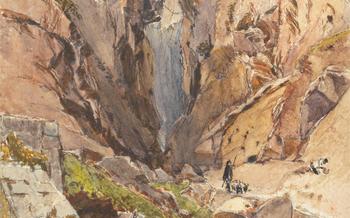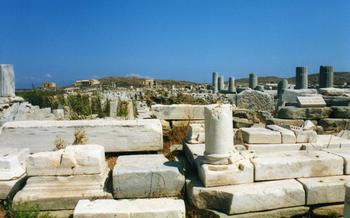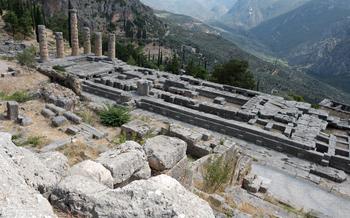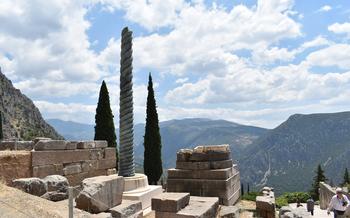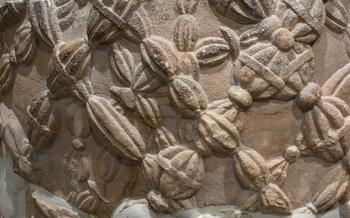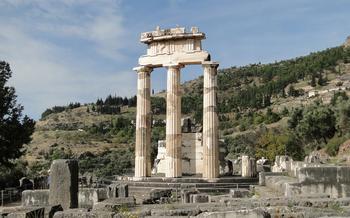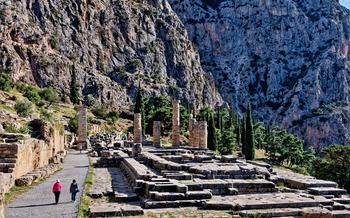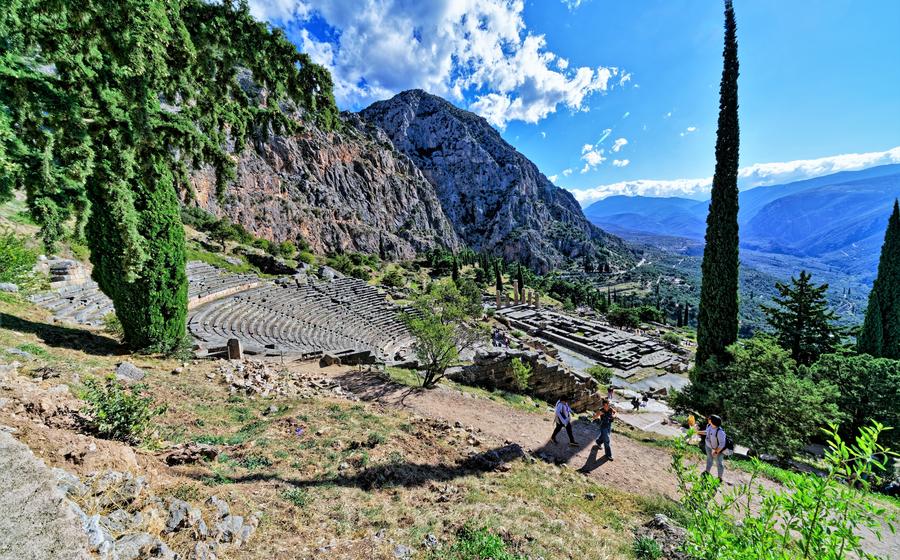
Archaeological Museum of Amfissa
- Delphi: A Journey Through History
- Archaeological Museum of Amfissa: A Treasure Trove of the Past
- Unveiling the Ancient World: Highlights of the Museum
- The Enigmatic Oracle: Delving into the Sacred
- Masterpieces of Sculpture: Admiring the Craftsmanship
- Time Travel with Interactive Exhibits
- A Walk Through the Past: Exploring the Archaeological Site
- Unraveling the Mysteries of the Oracle: Guided Tours
- A Sanctuary for the Muses: The Castalian Spring
- Capturing the Essence: Photography Tips
- Beyond the Museum: Exploring Amfissa Town
- Planning Your Visit: Practical Information
- Hidden Gems: Off-the-Beaten-Path Discoveries
- Insider Tip: Unveiling the Secrets of the Oracle
Delphi: A Journey Through History
Delphi, nestled in the heart of Greece, holds a profound place in history as a spiritual and cultural center that influenced the ancient world. It served as a sanctuary dedicated to the Greek god Apollo and housed the renowned oracle, regarded as a divine source of guidance and wisdom. The oracle's prophecies and pronouncements shaped religious beliefs, political decisions, and the lives of individuals throughout the Hellenic realm.
Designated as a UNESCO World Heritage site, Delphi stands as a timeless testament to the rich heritage and profound impact of ancient Greek civilization. This sacred site invites travelers to embark on a journey through time, uncovering the mysteries and marvels of a civilization that continues to captivate the imagination.
Archaeological Museum of Amfissa: A Treasure Trove of the Past
Located in the picturesque town of Amfissa, just a short drive from Delphi, the Archaeological Museum of Amfissa stands as a testament to the rich cultural and historical heritage of the region. Easily accessible by car or public transportation, the museum offers a comprehensive overview of the area's past, from the Neolithic period to the Roman era.
Upon entering the museum, visitors are greeted by an impressive collection of artifacts that span centuries of human history. From intricate pottery and sculptures to inscriptions and everyday objects, the museum's exhibits provide a glimpse into the daily lives, religious beliefs, and artistic traditions of the ancient inhabitants of this region.
The museum's collection is particularly notable for its comprehensive representation of the various periods of Greek history. From the Neolithic period, with its distinctive tools and pottery, to the Bronze Age, with its impressive metalwork and jewelry, the museum offers a comprehensive journey through time. The Classical and Hellenistic periods are also well-represented, with a stunning array of sculptures, coins, and inscriptions that showcase the artistic achievements and cultural influences of the time.
Unveiling the Ancient World: Highlights of the Museum
The Archaeological Museum of Amfissa houses a diverse collection of artifacts spanning from the Neolithic period to the Roman era, offering a comprehensive glimpse into the region's rich history. Among the highlights are exquisite sculptures, intricate pottery, and fascinating inscriptions that provide valuable insights into the daily life, religion, and art of ancient Greece.
The museum's collection of sculptures is particularly noteworthy, showcasing the remarkable craftsmanship and artistic prowess of ancient Greek sculptors. From delicate marble statues to imposing bronze figures, these artworks depict a wide range of subjects, including gods, goddesses, heroes, and mythical creatures. The intricate details and lifelike expressions captured in these sculptures offer a testament to the skill and artistry of the ancient Greek sculptors.
Visitors can also admire a vast collection of pottery, ranging from simple utilitarian vessels to elaborately decorated vases. These artifacts provide a glimpse into the everyday lives of ancient Greeks, as well as their artistic traditions and techniques. The museum's collection includes examples of various pottery styles, including Geometric, Archaic, Classical, and Hellenistic, each with its own distinct characteristics and motifs.
In addition to sculptures and pottery, the museum also houses a collection of inscriptions, which offer valuable insights into the political, religious, and social life of ancient Greece. These inscriptions include decrees, laws, treaties, and dedications, providing firsthand accounts of historical events, religious practices, and the functioning of ancient Greek society.
The Enigmatic Oracle: Delving into the Sacred
The Oracle of Delphi was an ancient religious center where people sought guidance and prophecies from the gods. The oracle was believed to be the voice of Apollo, the Greek god of prophecy, and was consulted on important matters such as war, colonization, and personal decisions. The oracle's influence extended far beyond Delphi, reaching across the Greek world and beyond.
The rituals associated with the oracle were complex and sacred. Inquirers would first make offerings to Apollo and the other gods, then consult the oracle's priestess, known as the Pythia. The Pythia would enter a trance-like state, believed to be induced by vapors rising from a chasm in the earth, and deliver prophecies in enigmatic verses. These prophecies were then interpreted by priests and communicated to the inquirers.
The Oracle of Delphi played a significant role in shaping the course of history. Its prophecies influenced political decisions, religious practices, and the founding of new cities. The oracle's prestige and authority were such that even powerful rulers and military leaders sought its counsel before embarking on important endeavors.
Exploring the history and significance of the Oracle of Delphi is a journey into the realm of the sacred and the mysterious. It is an opportunity to unravel the secrets of a religious institution that shaped the ancient world and continues to fascinate people to this day.
Masterpieces of Sculpture: Admiring the Craftsmanship
The Archaeological Museum of Amfissa boasts a remarkable collection of sculptures that offer a glimpse into the artistic prowess of ancient Greek artisans. Among the highlights is the Kouros of Amfissa, an impressive life-size statue dating back to the 6th century BC. Carved from local limestone, the kouros stands tall and proud, exuding a sense of youthful vigor and athleticism. Its finely detailed features and intricate hairstyle showcase the sculptor's mastery of the human form.
Another notable sculpture is the Head of a Youth, a marble masterpiece from the 4th century BC. With its serene expression, delicate features, and flowing locks, the head embodies the ideals of classical Greek art. The artist's attention to detail is evident in the subtle rendering of the eyes, lips, and hair, capturing the essence of youthful beauty and innocence.
The museum also houses an impressive collection of relief sculptures, depicting scenes from mythology, history, and everyday life. These reliefs provide valuable insights into the beliefs, values, and artistic conventions of ancient Greek society. The intricate carvings showcase the exceptional skills of the sculptors, who used their chisels to transform stone into narrative masterpieces.
Exploring the museum's sculpture collection is a journey through time, allowing visitors to appreciate the evolution of Greek sculptural techniques and styles. From the archaic period, with its emphasis on form and symmetry, to the classical period, with its pursuit of idealized beauty and harmony, the sculptures offer a tangible connection to the artistic legacy of ancient Greece.
Time Travel with Interactive Exhibits
The Archaeological Museum of Amfissa embraces modern technology to offer interactive experiences that bring history to life for visitors of all ages. Multimedia presentations immerse visitors in ancient Greek culture, with virtual tours, 3D models, and historical reenactments. Interactive touchscreens and augmented reality displays allow visitors to explore artifacts in detail, learn about their significance, and engage with them in a dynamic way. Through these innovative exhibits, the museum provides a captivating and contemporary platform for understanding the rich heritage of the region.
A Walk Through the Past: Exploring the Archaeological Site
Adjacent to the Archaeological Museum of Amfissa lies the ancient city of Amfissa, a treasure trove of ruins that offers a glimpse into the rich history and culture of the region.
Within this sprawling archaeological site, visitors can wander among the remnants of temples, theaters, and public buildings, each whispering tales of the past. The Temple of Apollo, once a sacred sanctuary dedicated to the revered deity, stands as a testament to the city's religious devotion. The ruins of the ancient theater, where dramas and performances once captivated audiences, evoke the vibrant cultural spirit of Amfissa.
As you explore the site, the historical context and significance of each ruin unfold, revealing the intricate tapestry of life in ancient Greece. The Agora, the bustling marketplace where goods were exchanged and ideas were debated, transports visitors back in time, allowing them to envision the lively atmosphere of this commercial hub.
The archaeological site of Amfissa is not merely a collection of ruins; it is a living testament to the resilience, creativity, and ingenuity of the ancient Greeks. Through these remnants of the past, visitors can embark on a journey of discovery, unearthing the secrets and stories that lie beneath the surface of this captivating historical landscape.
Unraveling the Mysteries of the Oracle: Guided Tours
To truly delve into the enigmatic world of the Oracle of Delphi, consider embarking on a guided tour. Knowledgeable experts will lead you through the archaeological museum and the adjacent ancient site, providing invaluable insights into the history, significance, and rituals of the oracle. These tours offer a personalized and in-depth experience, allowing you to ask questions and gain a deeper understanding of the sacred site. Immerse yourself in the ancient world as you uncover the secrets of the oracle, its prophecies, and its profound influence on the course of history.
A Sanctuary for the Muses: The Castalian Spring
Nestled at the foot of the sacred mountain of Parnassus, the Castalian Spring holds a profound significance in Greek mythology and history. Ancients believed the spring to be a sacred sanctuary dedicated to the Muses, the nine goddesses who presided over the arts, literature, and music.
According to legend, the Castalian Spring was created when the mythical hero Pegasus, the winged horse, struck the ground with his hoof, causing a gush of water to erupt. This life-giving spring became a place of inspiration and creativity for those seeking the Muses' favor.
In ancient times, poets, musicians, and artists would make pilgrimages to the Castalian Spring to drink its waters, seeking divine inspiration and guidance for their creative endeavors. It was believed that anyone who drank from the spring would be blessed with poetic genius and artistic prowess.
Even today, the Castalian Spring continues to hold a special allure for visitors. Its crystal-clear waters and tranquil setting create an atmosphere of serenity and contemplation, inviting visitors to connect with the Muses and their creative spirit.
Capturing the Essence: Photography Tips
Composition and Angles: Pay attention to the composition of your shots and experiment with different angles to capture unique perspectives of the artifacts and ruins.
Lighting: Choose the right time of day for photography, as natural light can greatly enhance your images. Early morning or late afternoon light often provides a warm, golden hue.
Respectful Photography: Be mindful of the museum's rules and guidelines regarding photography. Flash photography may be restricted, and tripods might not be allowed in certain areas.
Focus and Depth of Field: Adjust your camera settings to achieve the desired focus and depth of field. A shallow depth of field can isolate a specific artifact or detail, while a larger depth of field can capture the entire scene.
Experiment with Perspectives: Try different vantage points and perspectives to create dynamic and interesting compositions. Get close to the artifacts to capture intricate details, or step back for a wider shot that includes the surrounding context.
Use Natural Light: Make the most of the natural light available within the museum. Position yourself to allow light to fall on your subject from the side or behind, creating depth and shadows.
Edit Wisely: After capturing your images, take the time to edit them carefully. Adjust exposure, contrast, and colors to enhance the overall look and feel of your photographs.
Beyond the Museum: Exploring Amfissa Town
Venturing beyond the confines of the Archaeological Museum of Amfissa, visitors are greeted by the enchanting town of Amfissa, a treasure trove of traditional Greek charm and hospitality. Stroll through its picturesque streets lined with local markets, boutiques, and tavernas, each exuding a unique character. Indulge in the town's vibrant culinary scene, savoring authentic Greek dishes prepared with fresh, local ingredients. From succulent grilled meats to mouthwatering seafood specialties, Amfissa's culinary delights will tantalize your taste buds and leave you craving for more. Immerse yourself in the town's rich history and culture, visiting the nearby Folk Art Museum, which houses a fascinating collection of traditional costumes, textiles, and artifacts that provide a glimpse into the region's past. Amfissa is a living testament to the enduring spirit of Greek culture, inviting visitors to experience its authentic charm and warm hospitality.
Planning Your Visit: Practical Information
Planning Your Visit: Practical Information
To ensure a smooth and enriching visit to the Archaeological Museum of Amfissa, it is essential to plan your trip with the following information:
-
Museum Hours: The museum is generally open from 8:00 AM to 3:00 PM, seven days a week. However, it is advisable to check the museum's official website or contact them directly for any updates or seasonal variations in operating hours.
-
Admission Fees: The standard admission fee for adults is €6, while reduced rates apply to students, seniors, and families. Free admission is offered to children under 12, members of the museum, and on specific days designated by the Greek Ministry of Culture.
-
Contact Details: For further inquiries or to make reservations for guided tours, you can reach the museum by phone at +30 22650 22210 or via email at [email protected].
-
Accessibility: The Archaeological Museum of Amfissa is committed to providing an accessible environment for visitors with disabilities. Wheelchair ramps, elevators, and accessible restrooms are available throughout the museum. Additionally, assistive devices and materials can be requested in advance to enhance your visit.
-
Facilities and Services: The museum offers a range of facilities and services to ensure a comfortable and enjoyable experience. These include a cloakroom, a museum shop where you can purchase souvenirs and educational materials, and a small café where you can relax and enjoy refreshments.
Hidden Gems: Off-the-Beaten-Path Discoveries
Beyond the main galleries of the Archaeological Museum of Amfissa, there are hidden gems waiting to be discovered. One such treasure is the collection of prehistoric tools and weapons, offering a glimpse into the earliest human settlements in the region. These artifacts, often overlooked by visitors rushing to see the more famous sculptures, provide a fascinating insight into the lives of our distant ancestors.
Venturing further off the beaten path, you may stumble upon a forgotten storeroom filled with ancient pottery shards, discarded fragments that once formed part of magnificent vessels. These broken pieces, though seemingly insignificant, tell a story of everyday life in ancient Greece, where pottery played a crucial role in domestic and religious rituals.
The museum also houses a small but impressive collection of coins from various periods of Greek history. These coins, often overlooked by visitors focused on the larger artifacts, offer a glimpse into the economic and political systems of ancient Greece. Each coin bears witness to the rise and fall of empires, the ebb and flow of trade, and the changing fortunes of the Greek people.
For those willing to explore beyond the museum walls, the archaeological site of Amfissa holds further hidden treasures. Scattered among the ruins of temples and public buildings are fragments of ancient inscriptions, offering tantalizing clues about the lives and beliefs of the city's inhabitants. These inscriptions, often overlooked by tourists rushing from one site to another, provide a glimpse into the rich cultural and intellectual heritage of ancient Greece.
Insider Tip: Unveiling the Secrets of the Oracle
For an unforgettable and immersive experience, plan your visit to coincide with one of the special events or ceremonies held at the Oracle of Delphi. These events provide a unique opportunity to witness the ancient rituals and traditions come to life. Participate in reenactments of oracle consultations, learn about the history and significance of the site from experts, and gain a deeper understanding of the sacred practices that shaped the ancient world. By stepping into the shoes of the ancients, you'll gain a new perspective on the enduring legacy of the Oracle of Delphi and its profound influence on history, religion, and culture.
